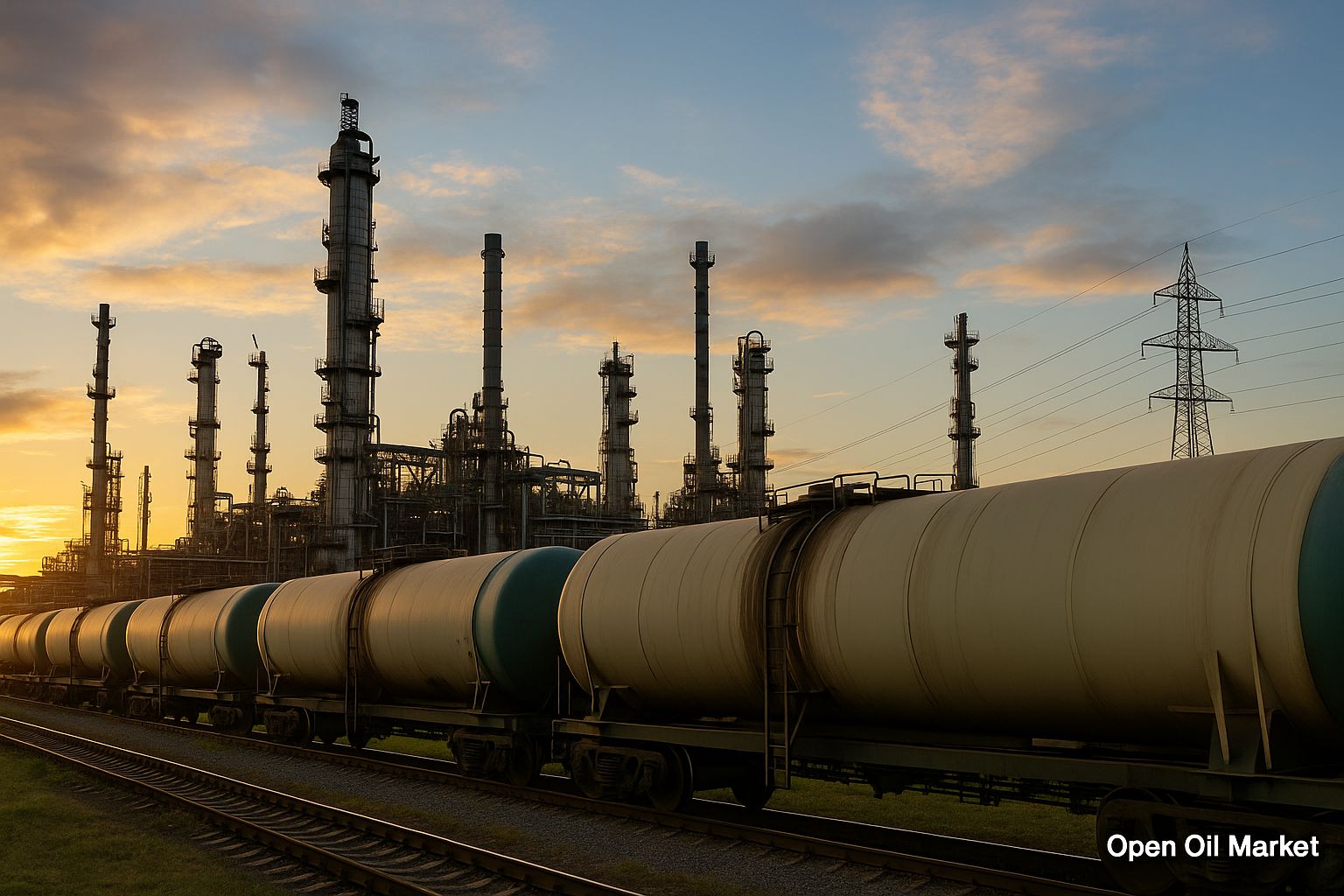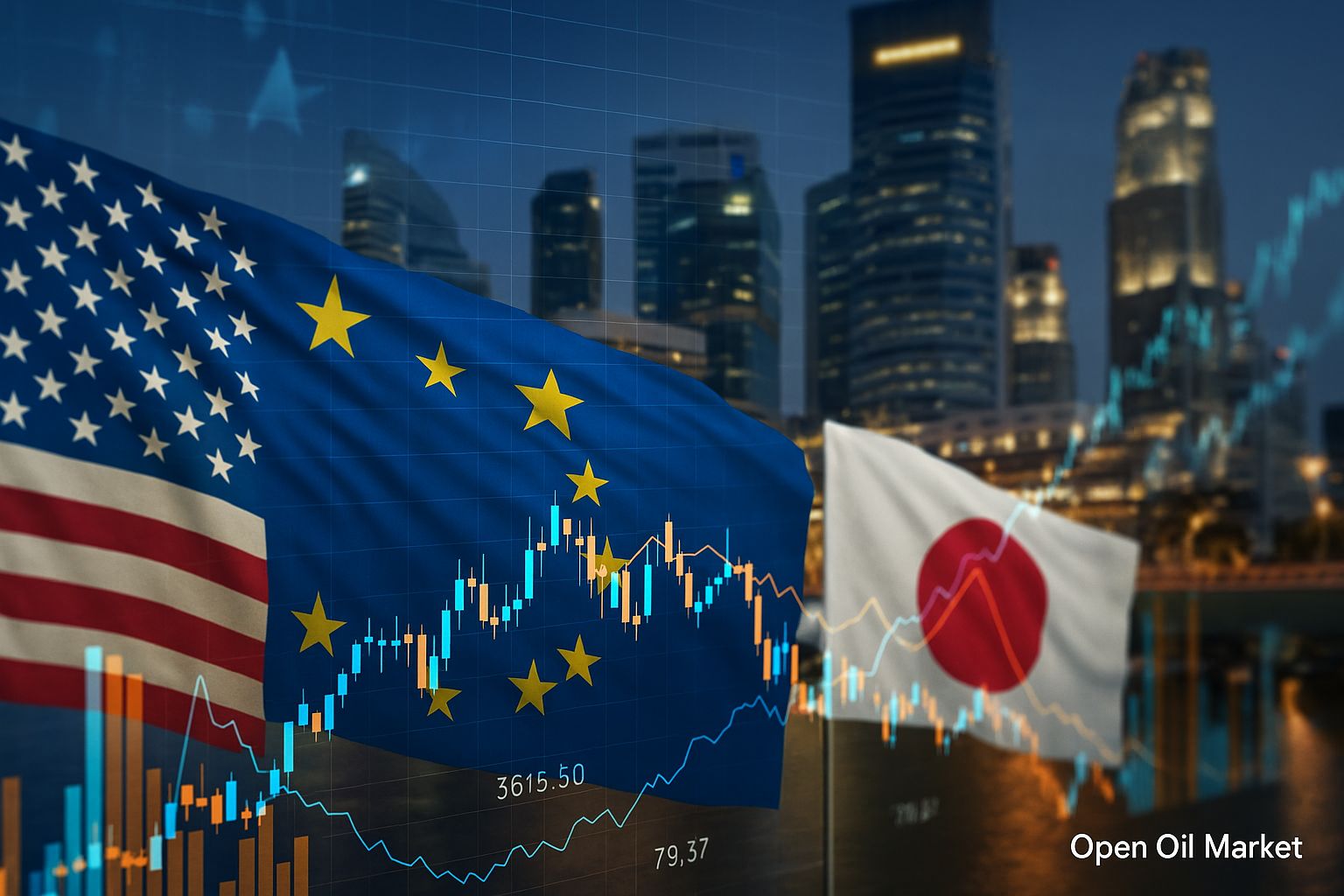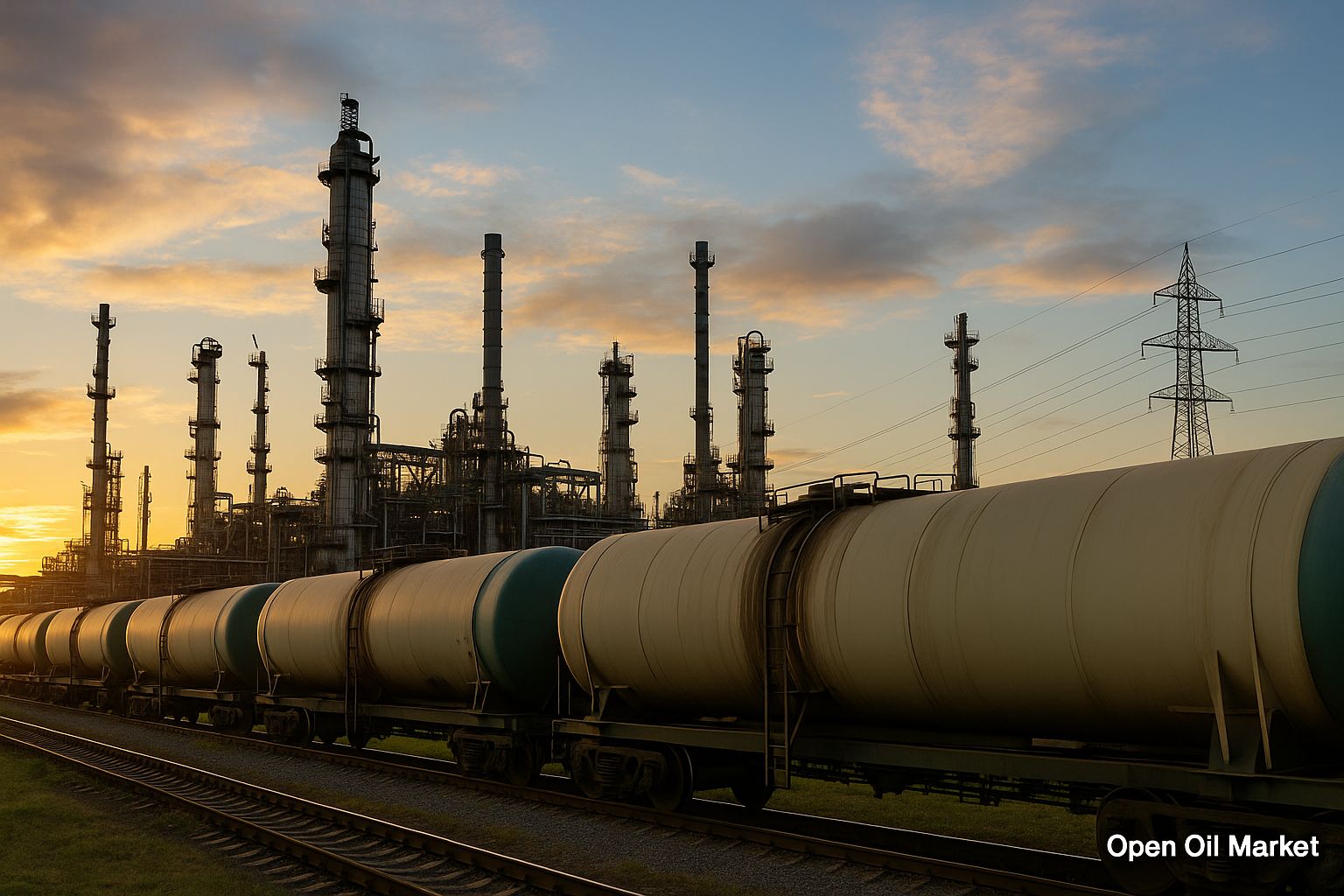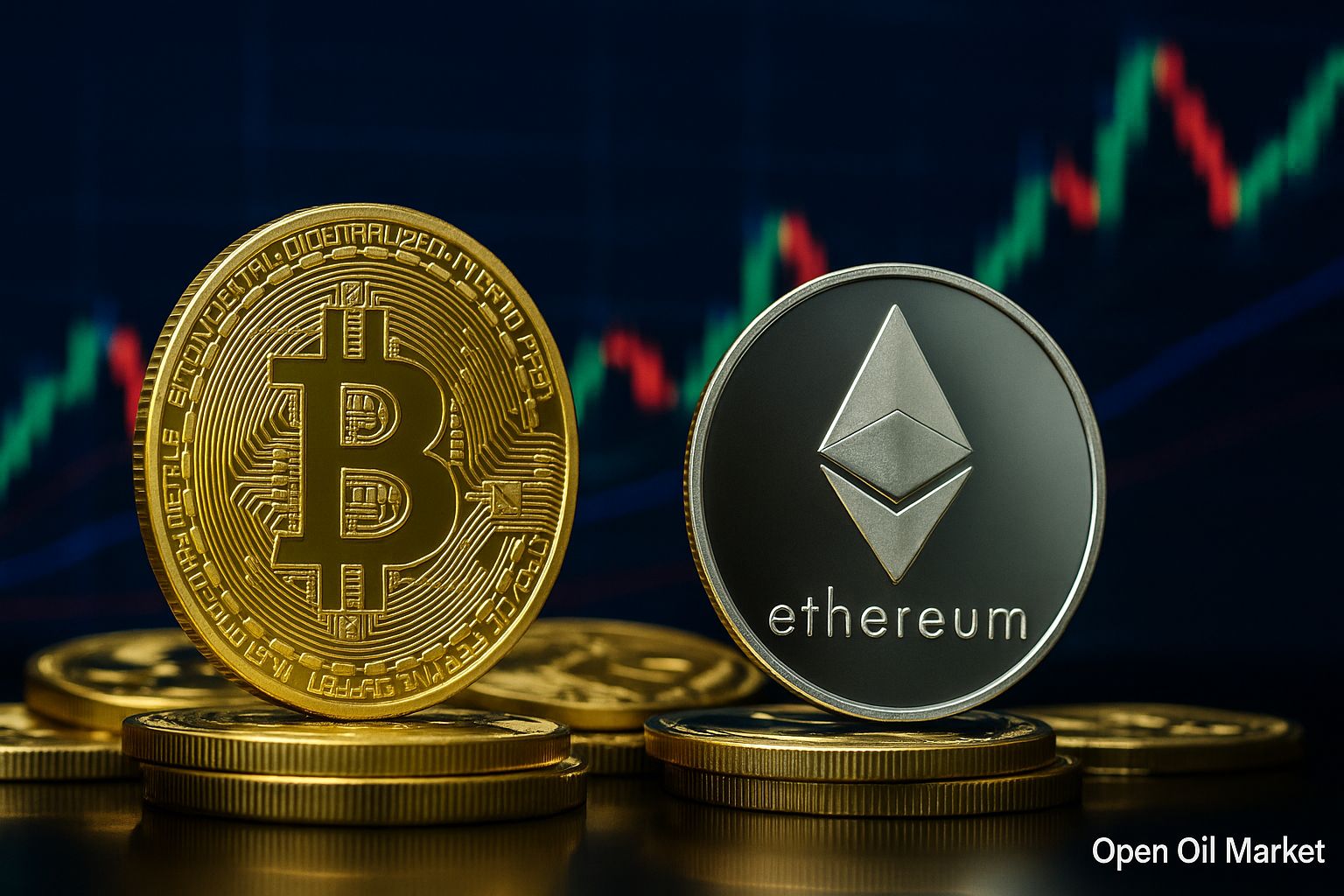
Current Energy Sector News as of August 25, 2025: Sanction Standoff Intensifies, Oil Nears $70, Gas Prices Rise Despite Record Inventories, Russia Reinforces Price Stabilization Measures for Fuel. Comprehensive Overview of the Global Fuel and Energy Complex.
The current events in the fuel and energy complex as of August 25, 2025, attract the attention of investors and market participants with their ambiguous signals. Ten days have passed since the long-awaited summit between Russia and the USA in Alaska—no direct breakthroughs in relations have occurred, and the negotiation process has stalled, heightening concerns about further escalation of the sanctions standoff.
The global oil market, which previously experienced pressure from oversupply and demand slowdown, shows signs of growth at the start of the new week—the prices of benchmark Brent are rising towards the upper limit of $60 per barrel (approaching the $70 mark), reflecting a fragile balance of factors.
The European gas market maintains high inventory levels: underground gas storage (UGS) facilities in the EU are over 90% full, providing a solid reserve ahead of winter. However, against the backdrop of ongoing uncertainty, gas prices have risen for the first time in several weeks.
Meanwhile, the global energy transition continues to accelerate. Many regions are recording new records in generation from renewable sources, although for the reliability of energy systems, countries are still not completely abandoning traditional resources.
In Russia, following a recent spike in prices, authorities are implementing a set of measures aimed at stabilizing the situation in the domestic fuel market. Below is a detailed overview of key news and trends in the oil, gas, power generation, and raw material sectors as of this date.
Oil Market: Prices Approach $70 Amid Contradictory Factors
Global oil prices rose for the first time last week after several weeks of decline, yet remain relatively stable under the influence of fundamental factors. The North Sea Brent blend increased from approximately $65 to about $68 per barrel (U.S. WTI rose to about $63–65), marking the first weekly price increase in three weeks. Current levels remain around 10% lower than prices a year ago, reflecting a gradual market correction after the peaks of the energy crisis of 2022–2023. The dynamics of prices continue to be influenced by several factors:
- OPEC+ Production Increase: The oil alliance steadily increases supply in the market. In August 2025, the total production quota of key participants in the deal was increased by approximately 548 thousand barrels per day; a comparable increase is expected in September. This policy continues the trend of previous months, as restrictions have gradually been eased since spring, leading to a rise in global oil and petroleum product inventories.
- Slowing Demand Growth: The pace of global oil consumption is declining. The International Energy Agency (IEA) revised its demand growth forecast for 2025 to about 0.7 million barrels per day (compared to over 2.5 million barrels per day in 2023). Even OPEC's estimates have become more restrained, around +1.3 million barrels per day for 2025. Reasons include weakened economic activity and high prices from previous years, which encourage energy savings. An additional factor has been a slowdown in industrial growth in China, which limits the appetite of the second-largest oil consumer.
- Geopolitical Uncertainty: A protracted conflict and new sanctions measures add risk premium to the market. On one hand, the lack of progress in resolving the crisis means that U.S. sanctions pressure on Russia remains (and in some cases intensifies), pushing prices upward. On the other hand, the very fact of ongoing diplomatic contacts somewhat mitigates panic. As a result, oil prices fluctuate within a narrow range, receiving no impetus for either a rapid rally or a sharp decline.
The combined effect of these factors creates a moderate oversupply, keeping the oil market in a state close to surplus. Exchange prices remain significantly below last year’s highs. A number of analysts believe that if current trends persist, the average Brent price could drop to around $50 per barrel by 2026.
Gas Market: Record Inventories Fail to Prevent Price Increases
The focus in the gas market is on Europe. EU countries are rapidly filling their natural gas storage facilities in preparation for the autumn-winter period; currently, European UGS are over 90% full, ensuring a substantial reserve for winter and previously maintaining prices at moderate levels. However, as hopes for a swift peace diminish, traders are once again factoring in risks of possible supply shortages into gas pricing. Against the backdrop of no prospects for the return of significant volumes from Russia and the commencement of a new phase of technical work at North Sea fields in Norway, European gas prices have started to rise.
Futures for the nearest month at the TTF hub have risen over the past week from approximately $380 to about $410 per 1,000 cubic meters—the first increase after several weeks of decline. In light of the prolonged conflict, Europe is likely to continue facing limitations on gas supplies, compensating for lost volumes through purchases of liquefied natural gas (LNG) and competing with Asia for higher prices. The pace of filling European inventories is currently slower than last year, although their absolute level is significantly higher, reducing the risk of shortages. Overall, gas prices remain well below the peak values of 2022 due to accumulated reserves and demand reduction measures. Nevertheless, the approaching winter and uncertainty regarding future supplies could sustain volatility in the gas market in the coming months.
International Politics: U.S.-Russia Dialogue on Hold, Sanction Pressure Rises
On August 15, a meeting took place between the presidents of Russia and the USA in Anchorage, Alaska. By the end of August, the outcomes remain unclear: a breakthrough on key issues has not been achieved, and negotiations have effectively stalled. U.S. President Donald Trump expresses a desire to organize a direct summit between Russia and Ukraine and is "watching the process from the sidelines,” but there has been no progress in preparing a meeting between Vladimir Putin and Volodymyr Zelensky. Russian Foreign Minister Sergey Lavrov noted the absence of a clear agenda for a potential summit, placing responsibility on Kyiv, which, according to him, is saying "no" to any constructive proposals.
As the likelihood of a swift ceasefire decreases, the risk of tightening Western sanctions against Russia increases. ING experts emphasize: the less realistic a quick peace seems, the higher the chances that Washington will move to strengthen restrictions. An unprecedented step targeting a Moscow ally has already been taken: Donald Trump signed a decree raising tariffs on imports from India by another 25 percentage points, bringing the total tariff to 50% starting August 27, as punishment for ongoing purchases of Russian oil by New Delhi. This move represents a new wave of sanction pressure, signaling that similar measures may also threaten other buyers of Russian energy resources. India expressed disappointment over the tariff imposition, stating that it was not warned of such harsh trade measures; at the same time, New Delhi claims that its oil imports from Russia are driven by national needs and cannot be sharply reduced.
The West continues to exert pressure on other fronts as well. The U.S. has imposed sanctions on several companies and tanker fleets involved in trading Iranian oil, while the UK has sanctioned an Iranian business magnate and associated structures. Although these measures do not directly affect Russia, they reflect an overarching trend towards strict control over global energy flows. Thus, international political factors continue to cast a shadow over the energy sector market: dialogue between the powers is paused, and the sanctions regime remains stringent, inhibiting the prospects for normalizing energy resource trade.
Asia: India Defies Pressure to Maintain Imports; China Increases Production
- India: Under unprecedented pressure from the West (including the U.S. doubling tariffs on Indian exports to 50% starting August 27 for cooperation with Russia), the country has unmistakably indicated that a sharp reduction in imports of Russian oil and gas is unacceptable due to the critical role these supplies play in its energy security. New Delhi has managed to negotiate more favorable conditions for itself: Russian companies are forced to provide an additional discount on Urals oil (about $5 off Brent prices) to maintain the Indian market. As a result, India continues to actively purchase Russian oil at favorable terms and even increases imports of oil products from Russia to satisfy growing domestic demand. At the same time, the country's leadership is taking steps towards reducing dependence on imports in the long term. Prime Minister Narendra Modi announced the launch of a national program for deep-water oil and gas exploration on Independence Day (August 15). Within this initiative, the state company ONGC has begun drilling ultra-deep wells (up to 5 km) in the Andaman Sea, and the initial results are already considered promising. This "deep-sea mission" aims to unlock new hydrocarbon reserves and move India closer to its goal of energy independence. Furthermore, during the meeting of foreign ministers in Moscow on August 21, India and Russia agreed to strengthen trade and economic ties, signaling New Delhi's intention to maintain cooperation in the energy sector despite external pressures.
- China: The largest economy in Asia is also increasing energy imports while simultaneously boosting its domestic production. Chinese importers remain among the main buyers of Russian oil and gas: Beijing has not joined the Western sanctions and has seized the opportunity to import raw materials at favorable terms. According to customs statistics from the PRC, in 2024, the country imported approximately 212.8 million tons of oil and 246.4 billion cubic meters of natural gas—these volumes increased by 1.8% and 6.2% respectively compared to the previous year. In 2025, the import of energy resources continues to grow, albeit at a more moderate pace due to last year’s high base. Concurrently, Beijing is fostering its own oil and gas production: from January to July 2025, national companies extracted 126.6 million tons of oil (+1.3% compared to the previous year) and 152.5 billion cubic meters of gas (+6%). The increase in domestic production helps partially offset rising consumption but does not eliminate the need for imports. Chinese authorities continue investing in the development of fields and technologies for enhancing well outputs. Nevertheless, considering the scale of the economy, China's dependency on energy resource imports will remain substantial: analysts estimate that in the coming years, the country will import no less than 70% of its consumed oil and about 40% of its used gas. Thus, the two largest Asian consumers—India and China—will maintain a key role in global commodity markets, combining strategies of securing overseas supplies with developing their own resource base.
Energy Transition: Record Growth in Renewables and the Role of Traditional Generation
The global transition to clean energy is rapidly gaining momentum. Many countries are recording new records in electricity generation from renewable sources. In Europe, the total generation from solar and wind power plants surpassed generation from coal and gas power plants for the first time at the end of 2024. This trend has continued into 2025: thanks to the commissioning of new capacities, the share of "green" electricity in the EU continues to grow, while the share of coal in the energy balance decreases after a temporary increase during the energy crisis of 2022–2023. In the U.S., renewable energy has also reached historic levels—at the beginning of 2025, more than 30% of total generation came from renewables, and the total volume of wind and solar energy production surpassed electricity generation from coal plants for the first time. China, the global leader in installed renewable capacity, is also continuously installing tens of gigawatts of new solar panels and wind turbines, consistently breaking its own generation records. According to the IEA, global investments in the energy sector are projected to exceed $3.3 trillion in 2025, with more than half of these funds directed towards renewable projects, grid modernization, and energy storage systems. In particular, the U.S. plans to add around 33 GW of new solar plants in the year—a record volume, accounting for almost half of all newly installed generating capacities.
However, energy systems still rely on traditional generation for stability. The growth of solar and wind shares creates challenges for grid balancing during hours when renewable generation is absent. To cover peak demand and reserve capacity, gas and even coal power plants are being reactivated in some cases. For instance, in certain regions of Europe last winter, there was a need to temporarily increase coal-fired generation during windless weather—despite the ecological costs. Governments of many countries are investing in developing energy storage systems (industrial batteries, pumped storage facilities) and “smart” grids that can flexibly manage load. These measures aim to improve the reliability of energy supply as the share of renewables increases. Experts predict that by 2026–2027, renewable sources may lead globally in electricity generation volume, definitively surpassing coal. However, in the coming years, the support of conventional power plants remains necessary as insurance against outages. Thus, the energy transition reaches new heights but requires a delicate balance between green technologies and traditional resources.
Coal: High Demand Supports Market Stability
Despite the rapid development of renewables, the global coal market retains significant volumes and remains a crucial part of the energy balance. Demand for coal is particularly high in the Asia-Pacific region, where economic growth and electricity needs drive intense consumption of this fuel. China, the world’s largest consumer and producer of coal, is maintaining coal burning at a level close to record highs in 2025. Chinese mines produce over 4 billion tons of coal annually, covering a large share of domestic needs; however, this barely suffices to meet record demand during peak load periods (for example, during hot summer months when air conditioning is widely used). India, possessing substantial coal reserves, is also increasing its use: over 70% of the country's electricity is still generated from coal-fired power plants, and absolute coal consumption is rising along with the economy. Other developing countries in Asia (Indonesia, Vietnam, Bangladesh, and others) are building new coal-fired power plants to meet the growing demands of their populations and industries.
Global coal production and trading have adapted to consistently high demand. Major exporters—Indonesia, Australia, Russia, and South Africa—have increased their production and export of thermal coal in recent years, helping to keep prices relatively stable. After price spikes in 2022, thermal coal prices have returned to more normal levels and have fluctuated within a narrow range in recent months. For example, the price of coal at the European ARA hub currently hovers around $100 per ton. The supply-demand balance appears favorable: consumers are guaranteed fuel, while producers keep a stable market at profitable prices. Although several countries have announced plans to gradually reduce coal use for climate goals, over the next 5–10 years, this energy source will remain irreplaceable in ensuring electricity supply for billions of people. Experts believe that in the coming decade, coal generation, particularly in Asia, will continue to play a significant role, even amid global decarbonization efforts. Thus, the coal sector is experiencing a period of relative equilibrium: demand is steadily high, prices are moderate, and the industry remains one of the pillars of the global energy system.
Russian Oil Product Market: Strengthened Measures to Stabilize Fuel Prices
Urgent steps are being taken in the Russian fuel market to normalize the price situation. In the first half of August, wholesale exchange prices for gasoline in the country reached new historical highs, exceeding the records of 2023. Amid high summer demand (the holiday season and the harvest campaign in the agriculture sector) and limited fuel supply in several regions, a local gasoline shortage emerged. The government has intensified market regulation: on August 14, an operational headquarters meeting was held under the chairmanship of Deputy Prime Minister Alexander Novak, during which a comprehensive set of steps was announced to reduce price surges, including:
- Extension of Export Ban: The complete ban on the export of automotive gasoline and diesel fuel from Russia, introduced in early August, has been extended until the end of September and applied to all producers (including major oil companies).
- Partial Resumption of Exports: It is expected that from October, restrictions will be partially eased—if the market balance improves by that time, large oil refineries will be allowed to resume certain exports, while for independent oil depots, traders, and small refineries, the embargo will likely remain in place.
- Monitoring Fuel Distribution: One of the reasons for shortages has been unplanned shutdowns at several refineries (accidents and drone attacks rendered major plants inoperable, reducing gasoline output). Authorities are now intensifying oversight of resource distribution within the country. Producers are directed to prioritize meeting domestic market needs and avoid mutual exchange market purchases of fuel, which previously drove prices up. The Ministry of Energy, the Federal Antimonopoly Service, and the St. Petersburg International Mercantile Exchange are developing long-term measures to enable direct contracts between refineries and end fuel suppliers, bypassing the exchange to eliminate unnecessary intermediaries from the sales chain.
- Subsidies and Dampers: Budget subsidies and a “reverse excise tax” (so-called dampers) continue to compensate oil producers for part of their lost export revenues, encouraging them to retain larger quantities of products in the domestic market.
The combination of these measures is aimed at gradually stabilizing prices and preventing fuel shortages. The extension of the export ban should redirect an additional 200–300 thousand tons of gasoline to the domestic market each month—approximately the volume previously sent for export. Simultaneously, subsidies maintain the economic incentive to prioritize domestic supply. The government states it is acting proactively: if necessary, export restrictions on petroleum products will be extended further, and regions facing shortages will promptly receive additional resources from reserves. So far, the fuel crisis is managed: despite record exchange prices, retail fuel costs at gas stations have only increased by about 5% since the beginning of the year (within the inflation limits). It’s crucial to avoid a repeat of last year’s scenario when a sharp spike in gasoline prices in certain months severely impacted consumers and agrarians. Currently, stations are well-supplied with fuel, and the measures implemented are gradually cooling exchange prices.
Monitoring of the situation continues at the highest level. On August 25, Deputy Prime Minister Alexander Novak will hold another meeting of the operational headquarters on the fuel market, while the Ministry of Finance and the Ministry of Energy will present calculations for adjusting the parameters of the fuel damper (retroactively from August 1) by September 10. An increase in the permissible range for wholesale prices' deviation from indicative levels is anticipated while maintaining compensations, ensuring that oil companies continue to receive budget payouts even at current high prices. This will allow them to direct fuel to the domestic market despite limited exports. Thus, the state will enhance the effect of the adopted measures and is ready to promptly implement new tools if necessary—to guarantee stable fuel supply to the domestic market and keep prices for end consumers within acceptable bounds.
Telegram Channel OPEN OIL MARKET – Daily Analytics on Energy Sector
To stay updated on current events and trends in the fuel and energy market, subscribe to our Telegram channel OPEN OIL MARKET (@open_oil_market). You will find daily reviews, industry insights, and exclusive analytics that will help you respond swiftly to changes in the oil, gas, and other energy markets.




